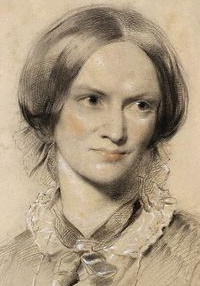
Charlotte Brontë was an English novelist and poet, the eldest of the three Brontë sisters who survived into adulthood and whose novels became classics of English literature. She is best known for her novel Jane Eyre, which she published under the gender neutral pen name Currer Bell. Jane Eyre went on to become a success in publication, and is widely held in high regard in the gothic fiction genre of literature.
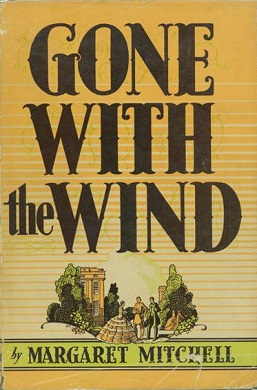
Gone with the Wind is a novel by American writer Margaret Mitchell, first published in 1936. The story is set in Clayton County and Atlanta, both in Georgia, during the American Civil War and Reconstruction Era. It depicts the struggles of young Scarlett O'Hara, the spoiled daughter of a well-to-do plantation owner, who must use every means at her disposal to claw her way out of poverty following Sherman's destructive "March to the Sea". This historical novel features a coming-of-age story, with the title taken from the poem "Non Sum Qualis eram Bonae Sub Regno Cynarae", written by Ernest Dowson.
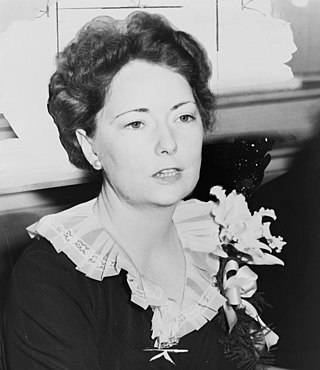
Margaret Munnerlyn Mitchell was an American novelist and journalist. Mitchell wrote only one novel, published during her lifetime, the American Civil War-era novel Gone with the Wind, for which she won the National Book Award for Fiction for Most Distinguished Novel of 1936 and the Pulitzer Prize for Fiction in 1937. Long after her death, a collection of Mitchell's girlhood writings and a novella she wrote as a teenager, titled Lost Laysen, were published. A collection of newspaper articles written by Mitchell for The Atlanta Journal was republished in book form.
Barbara Mary Crampton Pym was an English novelist. In the 1950s she published a series of social comedies, of which the best known are Excellent Women (1952) and A Glass of Blessings (1958). In 1977 her career was revived when the critic Lord David Cecil and the poet Philip Larkin both nominated her as the most underrated writer of the century. Her novel Quartet in Autumn (1977) was nominated for the Booker Prize that year, and she was elected as a Fellow of the Royal Society of Literature.

Emily Elizabeth Dickinson was an American poet. Little-known during her life, she has since been regarded as one of the most important figures in American poetry. Dickinson was born in Amherst, Massachusetts, into a prominent family with strong ties to its community. After studying at the Amherst Academy for seven years in her youth, she briefly attended the Mount Holyoke Female Seminary before returning to her family's home in Amherst. Evidence suggests that Dickinson lived much of her life in isolation. Considered an eccentric by locals, she developed a penchant for white clothing and was known for her reluctance to greet guests or, later in life, even to leave her bedroom. Dickinson never married, and most of her friendships were based entirely upon correspondence.

Katie Scarlett O'Hara Hamilton Kennedy Butler is a fictional character and the protagonist in Margaret Mitchell's 1936 novel Gone with the Wind and in the 1939 film of the same name, where she is portrayed by Vivien Leigh. She also is the main character in the 1970 musical Scarlett and the 1991 book Scarlett, a sequel to Gone with the Wind that was written by Alexandra Ripley and adapted for a television mini-series in 1994. During early drafts of the original novel, Mitchell referred to her heroine as "Pansy", and did not decide on the name "Scarlett" until just before the novel went to print. PBS has called O'Hara "quite possibly the most famous female character in American history..."
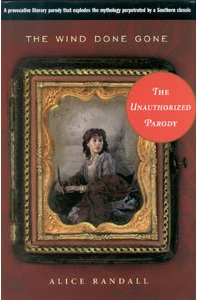
The Wind Done Gone (2001) is the first novel written by Alice Randall. It is a bestselling historical novel that tells an alternative account of the story in the American novel Gone with the Wind (1936) by Margaret Mitchell. While the story of Gone with the Wind focuses on the life of the daughter of a wealthy slave owner, Scarlett O'Hara, The Wind Done Gone tells the story of the life of slaves, Cynara, an enslaved woman during the same time period and events.

Margaret Mary Julia Devlin, known as Daisy Ashford, was an English writer who is most famous for writing The Young Visiters, a novella concerning the upper class society of late 19th century England, when she was just nine years old. The novella was published in 1919, preserving her juvenile spelling and punctuation. She wrote the title as "Viseters" in her manuscript, but it was published as "Visiters".
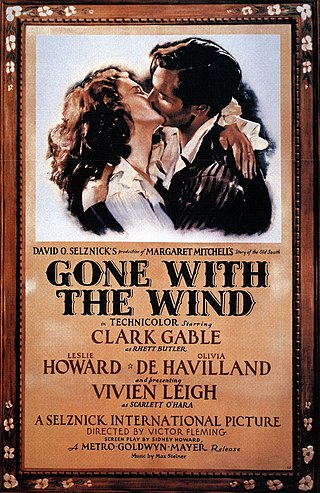
Gone with the Wind is a 1939 American epic historical romance film adapted from the 1936 novel by Margaret Mitchell. The film was produced by David O. Selznick of Selznick International Pictures and directed by Victor Fleming. Set in the American South against the backdrop of the Civil War and the Reconstruction era, the film tells the story of Scarlett O'Hara, the strong-willed daughter of a Georgia plantation owner, following her romantic pursuit of Ashley Wilkes, who is married to his cousin, Melanie Hamilton, and her subsequent marriage to Rhett Butler.

Caroline Pafford Miller was an American novelist. She gathered the folktales, stories, and archaic dialects of the rural communities she visited in her home state of Georgia in the late 1920s and early 1930s, and wove them into her first novel, Lamb in His Bosom, for which she won the Pulitzer Prize for Fiction in 1934, and the French literary award, the Prix Femina Americain in 1935. Her success as the first Georgian winner of the fiction prize inspired Macmillan Publishers to seek out more southern writers, resulting in the discovery of Margaret Mitchell, whose first novel, Gone with the Wind, also won a Pulitzer Prize for Fiction in 1937. Miller's story about the struggles of nineteenth-century south Georgia pioneers found a new readership in 1993 when Lamb in His Bosom was reprinted, one year after her death. In 2007, Miller was inducted into the Georgia Writers Hall of Fame.

Maeve Brennan was an Irish short story writer and journalist. She moved to the United States in 1934 when her father was assigned by the Department of Foreign Affairs to the Irish Legation in Washington, D.C. She was an important figure in both Irish diaspora writing and in Irish literature itself. Collections of her articles, short stories, and a novella have been published.

Margaret Sutton was the pen name of Rachel Beebe, an American author and teacher who is famous as being the author of the Judy Bolton Series of mystery books, 38 volumes published between 1932 and 1967. In addition to this series, she also wrote the Gail Gardner series, The Magic Maker series, Palace Wagon Family, Jemima, Daughter of Daniel Boone, as well as several other books.
Joseph Ferdinand Gould was an American eccentric, also known as Professor Seagull. Often homeless, he claimed to be the author of the longest book ever written, An Oral History of the Contemporary World, also known as An Oral History of Our Time or Meo Tempore. He inspired the book Joe Gould's Secret (1965) by Joseph Mitchell, and its film adaptation (2000), and is a character in the 2009 computer game The Blackwell Convergence.
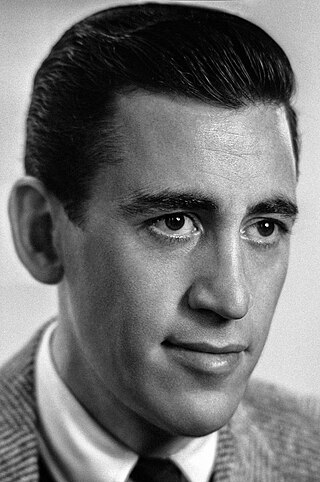
Jerome David Salinger was an American author best known for his 1951 novel The Catcher in the Rye. Salinger published several short stories in Story magazine in 1940, before serving in World War II. In 1948, his critically acclaimed story "A Perfect Day for Bananafish" appeared in The New Yorker, which published much of his later work.
"What Happened to Frederick" is the 13th episode of the American fairy tale/drama television series Once Upon a Time, which aired in the United States on ABC on February 19, 2012.
Margaret Jewett Smith Bailey (1812?–1882) was an American pioneer, missionary, and author from Oregon.
Lois Dwight Cole Taylor was an American editor and writer of children's literature. She wrote with her husband Allan Taylor as Allan Dwight. Their most successful novel was Drums in the Forest, first printed in 1936 and up to a 22nd printing in 1970. Most of her own novels were written as Anne Elliot. She also wrote as Anne Lattin, Nancy Dudley, Lynn Avery and Caroline Arnett.

Susan "Sue" Dowdell Myrick was an American journalist, educator, author, and conservationist. Her friendship with author Margaret Mitchell led to Myrick's role as a technical advisor and dialect coach during the production of Gone with the Wind (1939), ensuring the film accurately portrayed the accents, customs, and manners of the South. Due to this expertise she has been called the "Emily Post of the South". Myrick also was a columnist, reporter, and associate editor for Macon-based newspaper The Telegraph, working at the paper for fifty years.
Silvia Schulman was an American writer, interior designer, and building contractor. During the 1930s, she worked for the Hollywood film studios RKO Pictures, Metro-Goldwyn-Mayer, and later Selznick International Pictures as a secretary. She was producer David O. Selznick's personal assistant until February 1937, when she quit to marry screenwriter Ring Lardner Jr. During their honeymoon, she began to write a comic novel based upon her Hollywood experiences, and later enlisted the help of freelance writer Jane Shore. In 1938, I Lost My Girlish Laughter was published under the pseudonym Jane Allen.













